 |
Chris Bell | 'All I ask for is the chance to prove that money can't make me happy.' |
| - Spike Milligan |
 |
Chris Bell | 'All I ask for is the chance to prove that money can't make me happy.' |
| - Spike Milligan |
You will stay on this website. Do not refresh your browser, or you will have to visit Changelly.com to see your exchange progress.
Shortcut Scroll-Down Menu
Dogecoin (DOGE, symbol: Ð and D) is a Litecoin-derived cryptocurrency featuring a Shiba Inu from the Doge Internet meme on its logo. The users themselves call it "joky". One of the most popular uses of Dogecoin is the reward of Internet users for interesting and quality content created or shared by them. It was introduced on December 8, 2013. Compared to other cryptocurrencies, Dogecoin has a fast initial coin production schedule: there will be approximately 100 billion coins in circulation by the end of 2014 with an additional 5.2 billion coins every year thereafter. As of 3/30/2014, over 65 billion Dogecoins have been mined.
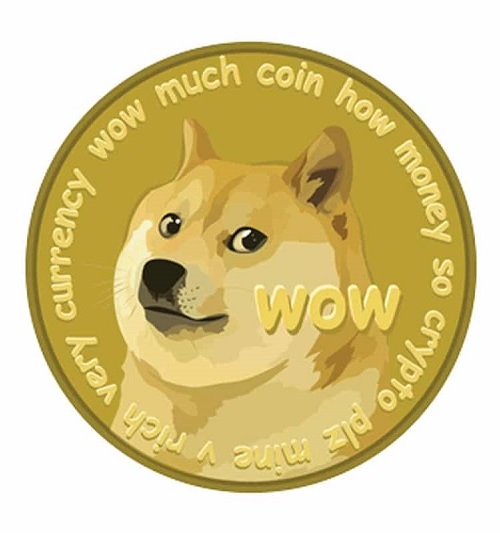
While there are currently few commercial applications for Dogecoin, the currency is gaining traction as an Internet tipping system, in which social media users grant Dogecoin tips to other users for providing interesting or noteworthy content. Many members of the Dogecoin community, as well as members of other cryptocurrency communities, use the phrase "To the moon!" to describe the overall sentiment of the coin's rising value.
Like in Bitcoin and Litecoin, in Dogecoin the public key cryptography is used, where a user generates a pair of cryptographic keys: a public one and a closed one. Only a closed key can decode the information encrypted with a public key; this is why the keys' owner can freely publish the public key without worrying about the encrypted data. The Dogecoin mining differs from Litecoin in several parameters. A new block in the Dogecoin chain is created in 1 minute unlike 2.5 minutes for Litecoin. Today, the mining complexity is reappointed once per block and the reward for miners is fixed. However, from the very beginning the complexity was changed once per four hours and the reward was a random number between 0 and maximum determined by the block parameters. In course of time the approach to the emission of coins has been changed as well. First, they wanted to limit it to 100 billion Dogecoin but then the issue of new coins became non-limited.
Dogecoin was created by programmer Billy Markus from Portland, Oregon, who hoped to create a fun cryptocurrency that could reach a broader demographic than bitcoin. In addition, he wanted to distance it from the controversial history of other coins, mainly bitcoins. At the same time, Jackson Palmer, a member of Adobe Systems' marketing department in Sydney, Australia, was encouraged on Twitter by a student at Front Range Community College to make the idea a reality.
After receiving several mentions on Twitter, Palmer purchased the domain dogecoin.com and added a splash screen, which featured the coin's logo and scattered Comic Sans text. Markus saw the site linked in an IRC chat room, and started efforts to create the currency after reaching out to Palmer. Markus based Dogecoin on the existing cryptocurrency, Luckycoin, which features a randomized reward that is received for mining a block, although this behavior was later changed to a static block reward in March 2014. In turn, Luckycoin is based on Litecoin, which also uses Scrypt technology in its proof-of-work algorithm. The use of scrypt means that miners cannot use SHA-256 bitcoin mining equipment, and that dedicated FPGA and ASIC devices used for mining are complicated to create. Dogecoin was officially launched on December 6, 2013. The Dogecoin network was originally intended to produce 100 billion Dogecoins, but later, it was announced that the Dogecoin network would produce infinite Dogecoins.
On December 19, 2013, Dogecoin jumped nearly 300 percent in value in 72 hours, rising from US $0.00026 to $0.00095, with a volume of billions of Dogecoins per day. This growth occurred during a time when bitcoin and many other cryptocurrencies were reeling from China's decision to forbid Chinese banks from investing Chinese Yuan into the bitcoin economy. Three days later, Dogecoin experienced its first major crash by dropping by 80% due to large mining pools seizing opportunity in exploiting the very little computing power required at the time to mine the coin.
On December 24, 2013, The Reserve Bank of India cautioned users of Dogecoin and other cryptocurrencies on the risks associated with them. On December 25, 2013, the first major theft attempt of Dogecoin occurred when millions of coins were stolen during a hacking attempt on the online cryptocurrency wallet platform Dogewallet. The hacker gained access to the platform's filesystem and modified its send/receive page to send any and all coins to a static address. This incident spiked Tweets about Dogecoin making it the most mentioned altcoin on Twitter. To help those who lost funds on Dogewallet after its breach, the Dogecoin community started an initiative named "SaveDogemas" to help donate coins to those who lost them. Approximately one month later, enough money was donated to cover all of the coins that were lost. By January 2014, the trading volume of Dogecoin briefly surpassed that of bitcoin and all other crypto-currencies combined, Dogecoin has a market capitalization of USD 13.5 million. April 2015 Jackson Palmer announced he is taking an "extended leave of absence" from the cryptocurrency community.

Dogecoin's implementation differs from Litecoin by several parameters. Dogecoin's block time is 1 minute as opposed to Litecoin's 2.5 minutes. The difficulty retarget time is once per block and the reward is fixed based on the block schedule listed below. However, when Dogecoin was first introduced, the difficulty retargeting was once every four hours, and the reward was a random number between 0 and a maximum defined by the block schedule. Under the system in which a random number of coins were distributed, rewards were calculated using a Mersenne Twister pseudo-random number generator. While the original implementation of Dogecoin meant for there to be a fixed number of coins per block from block 600,001 onwards only (providing 10,000 coins per block), the algorithms in Dogecoin were changed beginning from the 145,000th block so that a fixed reward was always given (providing 250,000 coins per block until block 200,001).
On March 12, 2014, version 1.6 of the Dogecoin client was announced. Along with allowing for there to be a fixed reward per block, the new client update also introduced a new difficulty algorithm called DigiShield. The main goal of the new difficulty algorithm, adopted from DigiByte, was to prevent multipools from being able to mine (and thereby profit) off the coin, reducing the price of the coin drastically, along with forcing single-coin miners to deal with the rise in difficulty the pools left in their wake. Thanks to the algorithm's near-instant change in difficulty, any multipool entering the Dogecoin network will immediately leave, as the difficulty of mining will spike upwards severely, causing a drop in profitability and, ultimately, an absence of multipools.
Several cases of using employer or university computers to mine Dogecoin have been discovered.
Several online exchanges offer DOGE/BTC and DOGE/LTC trading. Three exchanges, Mengmengbi, Bter and BTC38, offer DOGE/CNY trading. On January 8, 2014, AltQuick.co was the first exchange to launch DOGE/USD exchange. On January 30, 2014, Canada-based exchange Vault of Satoshi also announced DOGE/USD and DOGE/CAD trading. On February 2014, Hong Kong-based exchange Asia Nexgen announced that they would support the trading of Dogecoins in all major currencies. China-based exchange BTC38 also added their support on the Dogecoin exchange, boosting the market capitalization over 24 hours. In the first day of trading, Dogecoin was the second-most traded currency on the platform, after BTC.
On September 2014, UK-based exchange Yacuna began offering DOGE/EUR and DOGE/GBP trading.
On January 31, 2014, trading volume across the major exchanges was valued at $1.05 million USD. The market cap was US $60 million. Three exchanges accounted for the majority of volume: Bter (60%), Cryptsy (23%), and Vircurex (10%). The most traded currency pairs were DOGE/BTC (50%), DOGE/CNY (44%) and DOGE/LTC (6%).
Trading physical, tangible items in exchange for DOGE takes place on online communities such as Reddit and Twitter, where users frequently share currency-related information. On December 23, 2013, Tristan Winters of the online journal Bitcoin Magazine discussed what was needed for Dogecoin to replace bitcoin.
The first Dogecoin ATM was demoed at Coinfest in Vancouver in February 2014. Two bitcoin ATMs supporting Dogecoins and other altcoins opened in Tijuana, Mexico on March 17, 2014.
Dogecoin has also been used to try to sell a house, and has been used in the pornography and poker industries.
Weather forecasting mobile app, web application, and website Doge Weathers creators Katia Eirin and Bennett Wong request tips in Dogecoin to maintain their website.
Dogetipbot was a cryptocurrency transaction service used on popular sites like Reddit and Twitch.tv. It allowed users to send Dogecoins to other users through commands via Reddit comments; support for Twitch.tv and Twitter had been discontinued earlier. The service was launched in 2013 on Reddit. The trademark "dogetipbot" was officially registered on August 19, 2014. In November 2014, the developer team behind dogetipbot raised $445,000 in venture capital funding. In May 2017 Dogetipbot was discontinued and taken offline after its creator declared bankruptcy; this left many Dogetipbot users losing their coins stored in the Dogetipbot system.

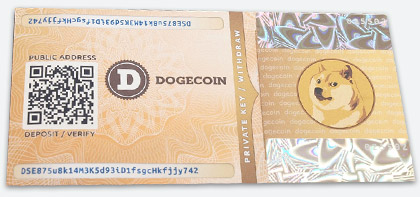
Dogecoin wallets come in a variety of forms designed for different types of devices. There are five main types: a boot program-wallet on a computer, mobile version, web application, paper and portable. Here is a list of wallets with a user – friendly interface and for safe storage of Doge:
Unlike deflationary cryptocurrencies (like Bitcoin), there is no limit to how many Dogecoins can be produced. This puts Dogecoin in the same league as other inflationary coins. According to the current production schedule, approximately 98 billion coins have been released by February 2015, with block 600,000 mined on February 25. Thereafter, approximately 5.256 billion more coins will be produced per year, in perpetuity. This represents an inflation rate of 5.256% (in 2015), that will decay over time due to new coins being introduced into the economy (e.g. in 2025 yearly inflation rate will be 3.4%, in 2035 2.5%, etc...). During December 2013 and January 2014, Dogecoin's developers discussed in public forums whether the inflation rate should be changedand, on February 2, 2014, Dogecoin founder Jackson Palmer announced that the supply of coins would remain uncapped, resulting in constant reduction of its inflation rate over a long time.
https://en.bitcoinwiki.org/wiki/Dogecoin#Dogecoin_Review
Cryptographically secure virtual currency exploded onto the scene in 2009 with the introduction of Bitcoin by Satoshi Nakamoto, the mysterious, and likely pseudonymous, developer of the currency. In the years since, Bitcoin has become the best-known, most widely circulated digital money in history. Bitcoin, with its technological design, has also inspired the development of many hundreds of other virtual currencies. In February 2016, more than 500 virtual currencies are traded in digital markets around the world every day. Few, however, come close to Bitcoin in influence, supply, trading volume or market capitalization.
Among the hundreds of virtual currencies available as of 2016, Litecoin and Dogecoin are two of the most influential alternatives to Bitcoin. Like Bitcoin, Litecoin and Dogecoin are decentralized, cryptographically secure digital currencies enabling peer-to-peer payments between any two people in the world without relying on government or regulatory oversight. Bitcoin supremacy seems certain to continue, even as the currency faces substantial growing pains; however, both Litecoin and Dogecoin also appear likely to continue as viable alternative digital currencies going forward.
Decentralized digital currencies, such as Bitcoin, Litecoin and Dogecoin, utilize cryptography and a public transaction ledger, known generically as a block chain, to ensure the security of peer-to-peer transactions. The Bitcoin block chain, for example, contains a record of every Bitcoin transaction since the currency's initiation in 2009. Sharing of this block chain occurs across the network so that every user with Bitcoin software can verify the past and current balance of every other Bitcoin user account on the network. Secure cryptographic methods protect the validity and the order of transactions in time within the block chain, ensuring that all Bitcoin accounts are accurate and current.
The transfer of bitcoins or another cryptocurrency from one user to another is also cryptographically protected. When a user sends bitcoins, a secret piece of data called a private key, which is known only to the user, adds a cryptographic signature to the transaction, proving to the rest of the network that the user authorized the transaction. The cryptographic signature also protects transactions from future alteration. Once a user initiates a transaction, the details begin broadcasting across the network. Before the transaction can be finalized in the block chain, however, other users on the network must complete a confirmation process known as mining.
Mining is a computer hardware-intensive, number-crunching process that cryptographically confirms transactions and inserts them into the block chain in proper chronological order. Once the mining process confirms a transaction, it is added to the distributed block chain and the transaction is complete. The process of mining is an optional activity on the Bitcoin network. Mining is in fact a competitive business. When a user successfully completes confirmation of a transaction block and that block is added to the block chain, the successful user receives a predetermined amount of newly created cryptocurrency as a reward for her efforts, in addition to an optional transaction fee paid by the user who initiated the transaction. The reward incentivizes the mining and ensures the continuing security of the cryptocurrency system.
Since its launch in 2009, Bitcoin has reigned as the world's most popular and widely accepted cryptocurrency. In 2015, the number of private merchants accepting payment in Bitcoin surpassed 100,000 for the first time. Retail purchases remained a small part of the payment network's overall transaction volume, which peer-to-peer payments dominate. According to an analysis by the U.S. Federal Reserve, worldwide retail payment volume averaged fewer than 5,000 bitcoins per day in February 2015, roughly 2.5% of the total transaction volume during the period. At the time, 5,000 bitcoins were worth about $1.2 million.
As of Feb. 2, 2016, 1 bitcoin is worth $374 on the open market. Prices adjust continually according to supply and demand, just like any market-determined exchange rate between two fiat currencies. Bitcoin payment volumes fluctuated between 180,000 and 240,000 transactions per day in the two weeks prior to Feb. 2. More than 15 million bitcoins are in circulation, giving the currency a dollar-denominated market capitalization approaching $5.7 billion. The Bitcoin system is designed to continually reduce the reward associated with Bitcoin mining until the supply of bitcoins grows to 21 million, which is a limit programmed into the system. Thereafter, miners must rely solely on transaction fees to pay for their efforts.
Charles Lee, an MIT graduate and former software developer at Google, launched Litecoin in 2011. The Litecoin cryptocurrency system is based substantially on the Bitcoin peer-to-peer protocol, with several technical differences designed as improvements over the Bitcoin system. The main technical difference noticeable to casual users is a reduction in the time it takes to process transactions. A Bitcoin transaction takes around 10 minutes to confirm, while Litecoin transactions take 2.5 minutes. Like bitcoins, litecoins are created through the mining process; however, Litecoin creation is capped at 84 million units, four times as large as the Bitcoin cap.
As of Feb. 2, 2016, 1 litecoin is worth just more than $3 on the open market. Payment volumes fluctuated between about 4,000 and 9,000 transactions per day in January, a fraction of the daily volume occurring on the Bitcoin network. The total number of litecoins in circulation exceeds 44 million. In dollar terms, the Litecoin market capitalization is nearly $136.5 million. Although hard figures are unavailable, it is safe to say that Litecoin is much less prevalent in retail environments than is Bitcoin. Thus, Litecoin continues primarily as a peer-to-peer payment system at the time of this writing, and it is likely to continue as such unless it gains in popularity in the coming months and years.
Launched in December 2013, Dogecoin began as something of a joke but progressed into a full-fledged cryptocurrency based on the Bitcoin system. It is named after Doge, an Internet meme combining pictures of a Shiba Inu dog with fragments of broken English. Dogecoin differs from Bitcoin and Litecoin in several respects. Most significantly for end users, Dogecoin miners require only about 1 minute to confirm a transaction, substantially less time than both its competitors. Additionally, the Dogecoin system has no cap on the number of dogecoins that users can mine. As long as miners continue operating, the Dogecoin supply continues to expand.
As of Feb. 2, 2016, 3,817 dogecoins are worth $1. Given the much higher mining reward, the total number of dogecoins in circulation already exceeds 102 billion. The supply is set to increase by an expected 5.2 billion dogecoins per year in perpetuity. The dollar-denominated market capitalization of the currency is just under $27 million. Payment volumes fluctuated between 14,000 and 22,000 in recent weeks. Dogecoin acceptance is not widespread in retail environments. People widely use the currency to give small tips to online content creators, forum participants and other worthy netizens.
https://www.investopedia.com/articles/investing/022016/bitcoin-vs-litecoin-vs-dogecoin-comparing-virtual-currencies.asp
By: William Carpenter
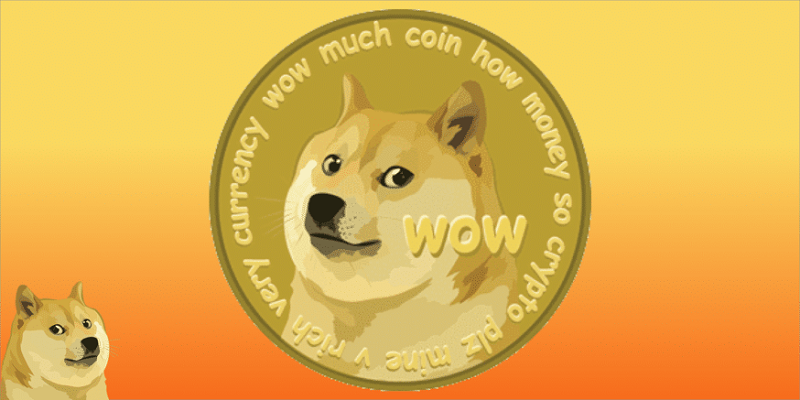
Dogecoin is an open source peer-to-peer digital currency. Part meme, part functional token, part legend in the cryptocurrency community, Dogecoin makes for an interesting case study. Dogecoin is like the class comedian who got kicked out of school for making jokes who ended up becoming a billionaire anyway.
While it's easy to dismiss Dogecoin as a joke, its supportive community and massive market cap is hard to ignore. The Dogecoin community consists of over 100,000 subscribers on Reddit.
Dogecoin is a peer-to-peer digital currency, just like Bitcoin and Litecoin. It was founded in 2013 by Jackson Palmer and "Shibetoshi Nakamoto". The site and project is laced with homages to its mascot, a Japanese shiba inu dog. For those unfamiliar with the meme, "doge" is derived from the word, and the memes often revolve around simple-minded expressions of emotion such as "much wow", "very crypto", and "such moon" in Comic Sans font.

The token is designed to have over 100 billion coins, a stark difference between that of its competition Bitcoin, which will only have 21 million total tokens. Dogecoin operates just as any other cryptocurrency; it can be mined or purchased on most exchanges.
Like any other token, Dogecoin is susceptible to extreme volatility and speculation. No one can predict the price of anything on the market or advise you whether or not to buy an asset. The ebbs and flows the of the market could swing Dogecoin in any direction, and you should be prepared to lose 100% of your investment in any cryptocurrency. That being said, Dogecoin saw some substantial growth in 2017. Its market cap broke $2 billion in January 2018, and the meme-based token started attracting media attention like never before.
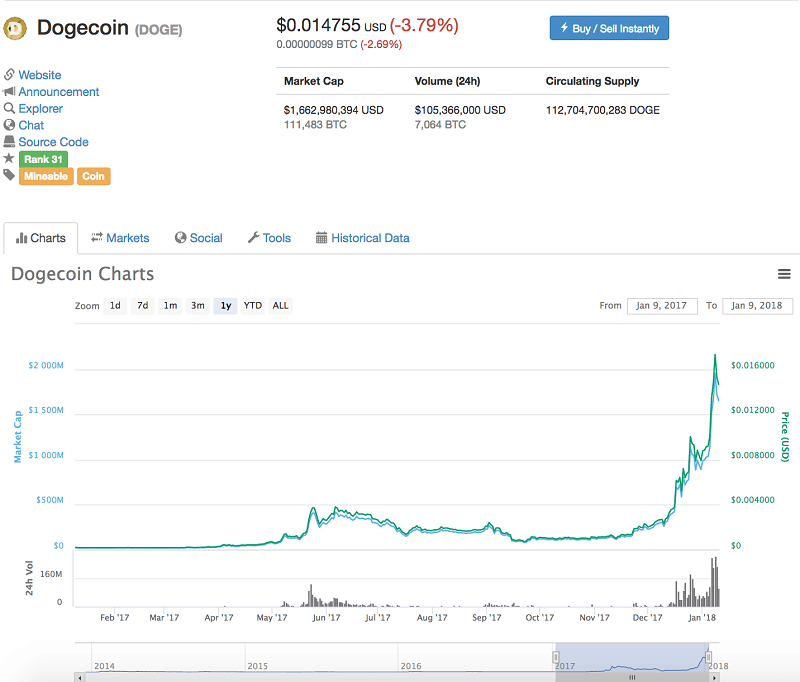
Although Dogecoin does have a peer-to-peer payment use case and a vibrant and active community, there isn't sufficient information for anyone to make a claim of whether you should invest in Dogecoin, or any cryptocurrency for that matter, or not.
A huge reason Dogecoin was able to break into popularity and stay popular is because of its widespread availability in exchanges. The most popular exchange for Dogecoin is Bittrex (upper 30%) and Poloniex (20%), as well as minor exchanges Gate.IO, HitBTC, Cryptopia, and CoinExchange, with the most popular pairing being BTC-DOGE.
Getting started with Dogecoin is a fairly simple process. New users can download the MultiDoge wallet from the site and set it up in under 5 minutes. Alternatively, users can store their Dogecoin either on their exchange wallets or whatever other wallets support the Doge.
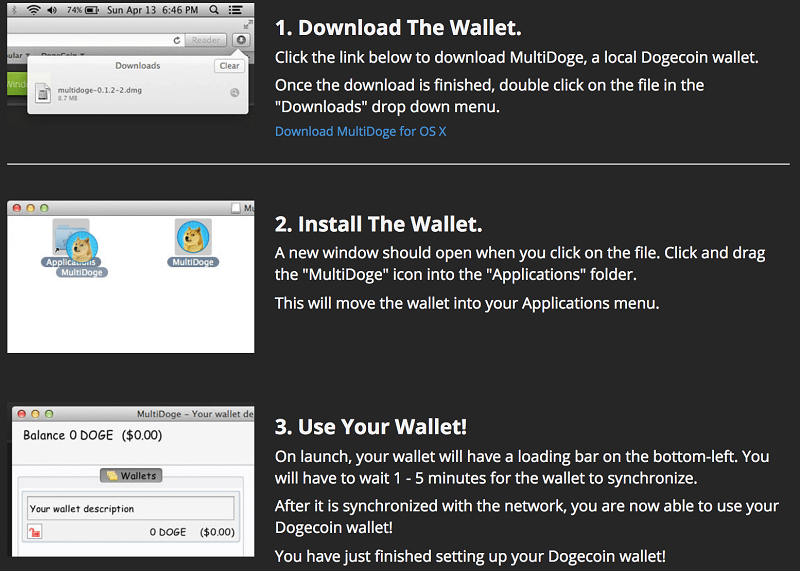
Perusing through Dogecoin's site, you'll see how simple the team has made the onboarding process.

The Dogecoin community created a (now seemingly defunct) non-profit organization called the Dogecoin Foundation to "facilitate the use of Dogecoin through goodwill, promotional, and charitable endeavors." The Dogecoin Foundation openly extends its arms to those who "want to spread the love using the magic of doge".

This Foundation also claims to make "massive efforts to help people whether they're on the moon or on Earth." The Dogecoin Foundation has an inactive Reddit profile (last post over 2 years ago) and Twitter profile. Other than that, not much to see here.
If there is one single golden lesson we can extract from the Dogecoin project is the importance of building a community. The token has been long dismissed as a joke by the cryptocurrency elite, yet Dogecoin is far from being obsolete thanks to its robust community of people that simply want to see the coin succeed for the sake of succeeding. Joke or not, Dogecoin has been able to accomplish something that few tokens can. It has been around for nearly 5 years, which garners some respect. An analysis of Dogecoin also adds some color to the current cryptocurrency landscape. This straightforward token doesn't pretend to be anything but what it is: a peer-to-peer digital currency. Among the thousands of whitepaper pages, complex theories, and pedantic explanations of the cryptocurrency market, Dogecoin is a rarity – and its community loves it.
https://coincentral.com/what-is-dogecoin/
By: Alex Moskov
What would you think if someone today created a new cryptocurrency, and it was very obvious from the start that it was intended to be satirical? A lot of people probably wouldn't even give it a second thought. That was certainly the case when Bitcoin Classic hit the scene last year. But when it comes to Dogecoin, the Internet embraced it.
Even today it's still a widely used, traded, and community supported cryptocurrency. It's available on almost every exchange, and is supported by a number of popular multi-asset wallets like Jaxx. So read on as we go over more about the history, present, and future of this silly yet highly effective cryptocurrency.
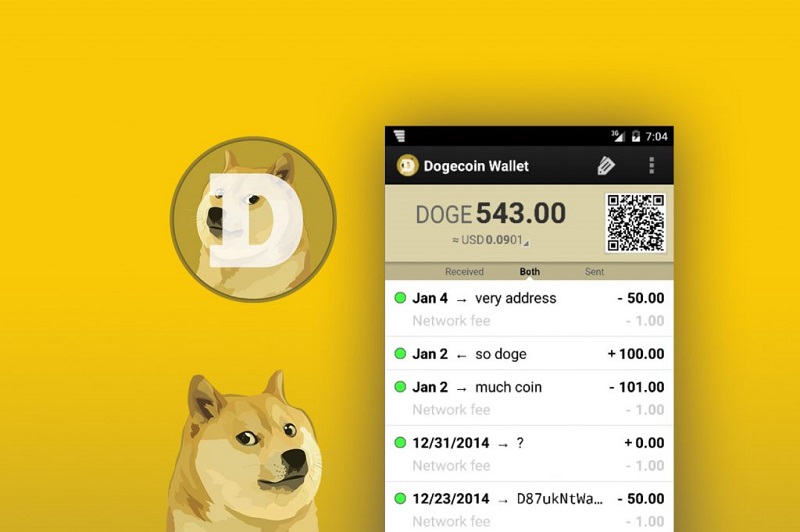
Created back in December 2013 by creators Billy Markus and Jackson Palmer, the currency was originally intended for two main purposes. Arguably, the primary purpose of Dogecoin was to act as a satirical commentary on the sudden explosion and ridiculous valuations of the new currencies coming out at that time. Back in 2013, all sorts of random and debatably pointless cryptocurrencies were created and had million-dollar market caps after just a few days online. One of those was "BBQ Coin", which at one point had a market cap of nearly $8 million, and is now effectively worth nothing.
The second goal was to create a currency that was fun and more readily accessible than the dominant bitcoin. Dogecoin was also designed to have a very large supply in the hundreds of billions so that each individual unit would always have a low price. Other intentions for the currency were to be used as an online tipping currency, such as for Reddit comments or YouTube videos, among other things.
The creators of Dogecoin used the popular Doge meme as the name and symbol for the new cryptocurrency. Word of the currency spread quickly through the Internet thanks to an innovative guerrilla marketing campaign using the characteristics of the Doge meme. This usually involved a picture of the Doge character alongside various broken English sentences that often took the structure of "much something", "very something", "such something", "wow". For example, "such crypto, many coin, very currency, wow" or something like it.
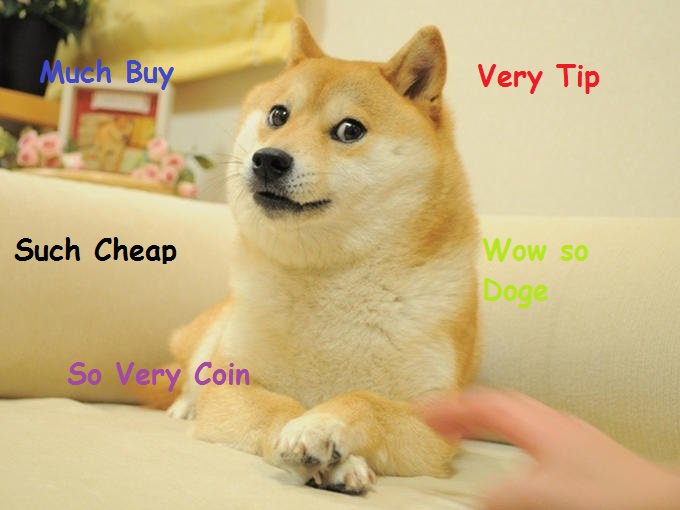
Dogecoin, Image from CCN.com
Dogecoin was created as a fork of Luckycoin, which itself was a fork of Litecoin. Therefore, Dogecoin contains a number of characteristics that are similar to Litecoin but not identical. For example, it uses the Scrypt algorithm which was originally designed so that bitcoin ASICs could not mine it. Of course, Scrypt ASIC miners exist today, but that was not the case back in 2013. Dogecoin also has a shorter block time than Litecoin.
Dogecoin was designed to have a very large supply, for the express purpose of keeping the currency accessible. While the entire market Of Dogecoin today is worth more than $750 million, individual tokens are still usually worth under one cent. This, again, was done on purpose. Additionally, Dogecoin does not have a fixed limit on the total supply. It is currently estimated that an additional 5.2 billion units will be made each year. Some critics have argued that this is a negative trait of Dogecoin because it can potentially prevent individual token values from rising. The currency did see a big jump in price just recently, but the market has since cooled off again and returned closer to it's normal range.
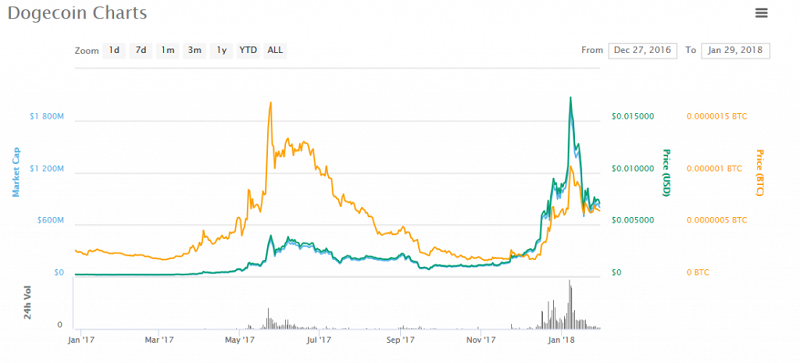
As a result of the low cost of the individual tokens, transaction fees are also significantly lower than other competitors. Typically less than one cent or so is all that it takes to send a transaction. Further, Dogecoin transactions are very fast and confirm quickly.
In response to the sudden price increase seen in December and January, Dogecoin co-creator Jackson Palmer commented on it on his Youtube channel. His advice was to wait until the market cools off before buying in. He suspected that "pump groups" were likely responsible for the jump in price.
Dogecoin is interesting because although it was meant to be satirical and just for fun, it has become an important mainstay in the cryptocurrency world. Due to its incredibly low transaction fees and fast transaction times, as well as relatively stable value, some traders are using it as a means of exchange. For example, if someone wants to withdraw money from a cryptocurrency exchange, it may be very expensive to do so if the currency is in bitcoin. Therefore, some traders may choose to first trade their bitcoin for Dogecoin and then withdraw their currency as Dogecoin before later converting again into something else.
Some use it purely for speculation since the price of each unit is so low. It's possible to purchase many millions of units without spending a fortune, and any small price increase can lead to reasonable market gains.
Dogecoin is also very widely accepted at almost every major exchange as well as several instant exchange services such as Shapeshift and Flyp.me. Because Dogecoin is integrated into Shapeshift, it can be used to pay for a wide variety of services and goods that have the Shapeshift API built-in.
Dogecoin has fallen on hard times more than once in its history. A highly divisive incident involving a cryptocurrency exchange followed by a massive theft resulted in many Dogecoin fans becoming disaffected, and abandoning the currency. As well, Dogecoin was removed from the Exodus wallet because Exodus claimed Dogecoin is not being developed and lacks several important updates.
"Although we love the Dogecoin community…the development seems to have gone stale with not many updates to key components we need. The last release of Dogecoin core was in Nov of 2015. Unfortunately Exodus is built on support from public Insight servers and Dogecoin does not have the latest updates to Insight. We have asked around and it does not seem this is going to happen anytime soon."
But what Dogecoin has going forward, however, outweighs its downsides. It is still accomplishing the original goals that it was set out to accomplish back in 2013. It is still a low-cost, easy to acquire, friendly and welcoming cryptocurrency. The Dogecoin community is especially quite famous for its friendliness and willingness to help new users. Dogecoin supporters are often seen giving out small amounts of the currency in order to encourage others to adopt it and understand it.
While the Doge meme may be all but forgotten for many, for the true believers, it is still a wide-reaching and effective symbol that unites the masses under a unified banner of solidarity. As waves of new users join cryptocurrency every day, many of them will inevitably use Dogecoin to get started, and of those, some will certainly stay and support the community and the currency for the foreseeable future.
https://blockonomi.com/dogecoin-guide/
By: Robert Devoe
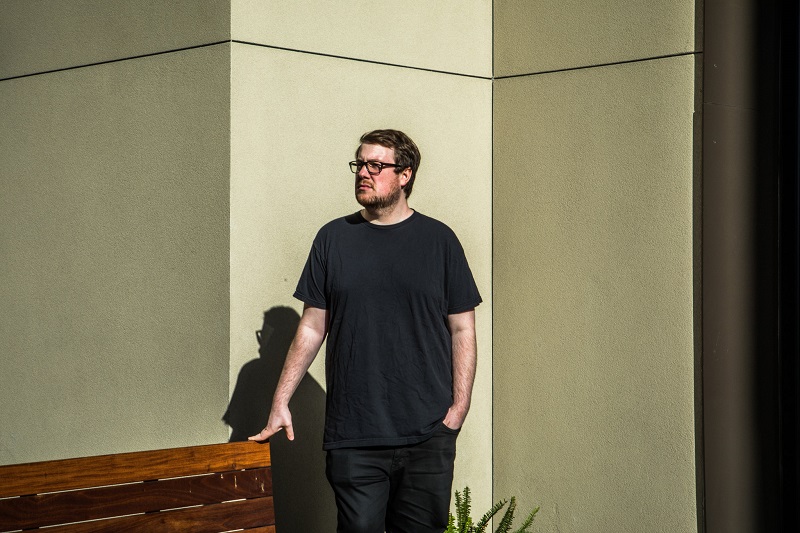
Jackson Palmer, creator of Dogecoin, in San Francisco on Friday. He was an early fan of cryptocurrency, but is now one of the loudest voices warning of a crash in the market. Christie Hemm Klok for The New York Times
Jackson Palmer no longer thinks it's funny to imitate Doge, the internet meme about a Shiba Inu dog whose awe-struck expressions and garbled syntax (e.g. "Wow. So pizza. Much delicious.") made him a viral sensation several years ago.
But if he did, he might channel Doge to offer a few cautionary words for investors who are falling for cryptocurrency start-ups, Silicon Valley's latest moneymaking craze:
Very bubble. Much scam. So avoid.
Mr. Palmer, the creator of Dogecoin, was an early fan of cryptocurrency, a form of encrypted digital money that is traded from person to person. He saw investors talking about Bitcoin, the oldest and best-known cryptocurrency, and wanted to find a way to poke fun at the hype surrounding the emerging technology.
So in 2013, he built his own cryptocurrency, a satirical mash-up that combined Bitcoin with the Doge meme he'd seen on social media. Mr. Palmer hoped to use Dogecoin to show the absurdity of wagering huge sums of money on unstable ventures.

But investors didn't get the joke and bought Dogecoin anyway, bringing its market value as high as $400 million. Along the way, the currency became a magnet for greed and attracted a group of scammers and hackers who defrauded investors, hyped fake products, and left many of the currency's original backers empty-handed.
Today, Mr. Palmer, 30, is one of the loudest voices warning that a similar fate might soon befall the entire cryptocurrency industry. "What's happening to crypto now is what happened to Dogecoin," Mr. Palmer told me in a recent interview. "I'm worried that this time, it's on a much grander scale." Already, there are signs of trouble on the horizon. This week, after Chinese authorities announced a crackdown on virtual currencies, the value of Bitcoin briefly tumbled 30 percent before partially recovering. The value of Dogecoin fell more than 50 percent last week. Its market value by midday Friday was about $100 million.
But there remains no bigger mania among tech investors than cryptocurrency, which some see as an eventual replacement for traditional, government-issued money. Even with the recent declines, the price of Bitcoin has more than tripled this year; another cryptocurrency, Ethereum, has gained more than 2,300 percent. The success of these currencies has minted a new class of "crypto-millionaires" and spawned hundreds of other digital currencies, called altcoins. In addition, it has given rise to an entire category of start-ups that take advantage of cryptocurrency's public ledger system, known as the blockchain.
Many cryptocurrency start-ups have raised money through an initial coin offering, or I.C.O., a type of fund-raising campaign in which investors buy into a new venture using Bitcoin or another cryptocurrency and receive virtual "tokens" instead of stock or voting rights in the company. These tokens grant investors access to a product or service that will be built with the money raised in the I.C.O., such as cloud data storage or access to a new social network.
(If you're having trouble picturing it: Imagine that a friend is building a casino and asks you to invest. In exchange, you get chips that can be used at the casino's tables once it's finished. Now imagine that the value of the chips isn't fixed, and will instead fluctuate depending on the popularity of the casino, the number of other gamblers and the regulatory environment for casinos. Oh, and instead of a friend, imagine it's a stranger on the internet who might be using a fake name, who might not actually know how to build a casino, and whom you probably can't sue for fraud if he steals your money and uses it to buy a Porsche instead. That's an I.C.O.)
Despite the obvious risks of these ventures, investor appetite has been ravenous. A group of Bay Area programmers this year used an I.C.O. to raise $35 million for their project, an anonymous web browser called Brave, in less than 30 seconds. There have been 140 coin offerings in 2017 that have raised a total of $2.1 billion from investors, according to Coinschedule, a website that tracks the activity.
I.C.O. fever has even infected celebrities. This month, the actress Paris Hilton tweeted that she was "looking forward to participating" in the initial coin offering of LydianCoin, a cryptocurrency project associated with the digital advertising company Gravity4. The boxing star Floyd Mayweather and the rapper the Game have also endorsed coin offerings.
Unlike traditional stock offerings, which are carefully supervised and planned months or years in advance, I.C.O.s are largely unregulated in the United States, although that could soon change. The Securities and Exchange Commission warned investors this year about the growing number of coin offerings, saying that "fraudsters often try to use the lure of new and emerging technologies to convince potential victims to invest their money in scams."
Mr. Palmer predicts that while some I.C.O.s may finance the creation of new and exciting enterprises, many will go up in smoke. He sees echoes of the first dot-com boom, when investors poured money into new and risky ventures only to get burned when the market came to its senses.
"People are treating cryptocurrency now like penny stocks," he said. "It's become a securities market." Other high-profile skeptics have sounded the alarm about a potential crash in the crypto market, including Jamie Dimon, the chief executive of JPMorgan Chase, who last week called Bitcoin a "fraud," and compared the current digital money craze to the 17th-century Dutch tulip bubble. And even true cryptocurrency believers have started to worry that I.C.O. mania won't end well.
"It's a ticking time bomb," Charles Hoskinson, one of the developers of the cryptocurrency Ethereum, told Bloomberg in July. When Mr. Palmer's interest in digital money began, just four years ago, cryptocurrency was the sole province of math geeks and early adopters. "It was fun, nobody took it seriously," he recalled. "People threw it around like change because it wasn't worth anything."
Unlike Bitcoin, whose early adopters often used it to buy drugs, weapons, or other illicit goods on the dark web, Dogecoin attracted a crowd of earnest do-gooders at first. They even set up a philanthropic arm, called the Dogecoin Foundation, and used it to raise thousands of dollars for projects, including sponsoring service dogs for autistic children and drilling water wells in Kenya. (Their generosity extended to quirkier projects; when Dogecoin fans heard that Jamaica's two-man bobsled team had qualified for the Winter Olympics in Sochi but lacked the money to get to Russia, they pitched in $30,000 to fund the trip.)
As the price of Bitcoin climbed, investors got interested in other cryptocurrencies. With no explanation, the price of Dogecoin doubled, then tripled. Two months after it was introduced, Mr. Palmer's joke was worth $50 million, and some early Dogecoin adopters, who called themselves "shibes," were sitting on lucrative stockpiles.
The success of Dogecoin attracted unsavory characters. One scammer raised $750,000 from Dogecoin supporters for a cryptocurrency start-up that never materialized. A hacker broke into Dogewallet, a website where users stored their coins, and stole thousands of dollars worth of the currency. Soon, the Dogecoin Reddit forum was full of angry scam victims and get-rich-quick schemers, and the once tight-knit Dogecoin community started to disintegrate.
"We tried to do everything right," said Ben Doernberg, a former board member of the Dogecoin Foundation. "But when you have a situation where people stand to put in a dollar and take out a thousand dollars, people lose their minds."
Mr. Palmer, a laid-back Australian who works as a product manager in the Bay Area and describes himself as "socialist leaning," was disturbed by the commercialization of his joke currency. He had never collected Dogecoin for himself, and had resisted efforts to cash in on the currency's success, even turning down a $500,000 investment offer from an Australian venture capital firm.
In 2015, he announced he was leaving Dogecoin behind, telling an interviewer that the cryptocurrency market "increasingly feels like a bunch of white libertarian bros sitting around hoping to get rich and coming up with half-baked, buzzword-filled business ideas." He recently began making a series of YouTube videos that explain tech topics to beginners, including how digital currencies work. His goal? To rekindle people's excitement in the core blockchain technology, while tamping down some of the excessive hype. "My mission in all of this is to help people better understand things, rather than just thinking about profit," he said.
It may be too late for that. Regulators in the United States have begun to scrutinize I.C.O.s, and China's central bank went as far as issuing a temporary ban on new coin offerings. But more dollars are still pouring into cryptocurrency ventures every day, as giddy investors ignore the warning signs and look to multiply their money. Mr. Palmer worries that the coming reckoning in the cryptocurrency market - and it is coming, he says confidently - will deter people from using the technology for more legitimate projects. "The bigger this bubble goes, the bigger negative connotation it's going to have," he said. "It's going to be like the dot-com bust, but on a much more epic scale."
https://www.nytimes.com/2017/09/15/business/cryptocurrency-bubble-doge.html
By: Kevin Roose
The bitcoin dream is a permissionless, decentralized currency immunized from predation by encryption where trusting anyone is unnecessary.
A system that doesn't need to trust, where a person doesn't need permission, ruled by laws that can be changed by anyone but only go into effect with consensus, is a political structure. How could the creation of money be otherwise, whether it be by a government or a kid in his bedroom.
[Ed note: Investing in cryptocoins or tokens is highly speculative and the market is largely unregulated. Anyone considering it should be prepared to lose their entire investment.]
Bitcoin's decentralized system works and hundreds of billions in value has been created by it. On its back has risen a whole juggernaut of crypto money that needs permission and requires trust and is centralized. These systems are anathema to the bitcoin dream and they have little kinship to bitcoin apart from using a blockchain and a method of encryption. They too, have created a huge amount of wealth--not because of bitcoin's anarchic vision but in spite of it.
Anarchy in its true sense rather than in its 'fake media' sense is a very tempting proposition, much like most creeds, but the benefits of it break down like most, because of the actions of the criminal element. This tiny 1%-2% of a population. It ruins things for everybody, be they community, communist, socialist, democrat or any permutation you can find in a book of political science. When you total up the cost of the criminal minority on your own life, the tax you pay to have things policed, the time wasted on locks and logins and other security measures, the negative impact of the criminal community is vast.
The criminal element in crypto is also ruining the dream. Not a day goes by that this tiny group of people is not tearing down the chance of a better world by their attempted or successful predations. The crypto-anarchy of blockchain is having a hard time flourishing under constant attack from criminals.
These ongoing and constant attacks will boost the fortunes of centralized cryptocurrencies, but the centralized blockchains are also stunted by the criminals and suffer criminal predations from the inside, like all centralized systems.
It seems however, that centralized crypto is winning. Once you strip out the non-minable coins and the tokens, a much smaller bitcoin/altcoin style ecosystem is revealed.
The bitcoin dream is overshadowed now by the centralized, unminable, trust-needing world.
This could be the outcome for crypto, the decentralized dream killed by constant attacks on the ecosystem by lawlessness and unchecked criminals.
It could be, but I don't believe it has to end that way. The bitcoin structure is a techno-anarchy and should, theoretically, be able to adapt. It has adapted and it still can while retaining the position as number one. It is the king of the crypto-jungle, so while contenders clamor with their old-order, centralized oligarchic models, the King of Crypto remains an anarchist.
This could mean the criminal community in the end can be controlled mechanistically and that the future will contain both decentralized and centralized systems.
This is all boring thought-leader stuff, but where is a great place to back a future for decentralized, permissionless... yada yada... currency like bitcoin?
The top pick remains bitcoin. Then comes monero because of its privacy strengths, which is increasingly a big deal in this surveillance society we have awoken in, and finally the long shot contender for me is the belittled dogecoin.
Why dogecoin? Because it is everything bitcoin stands for, a perfect example of crypto-techo-anarchy. Nobody owns it, nobody controls it, it's a jungle. If crypto-anarchy is part of the future, dogecoin will do extremely well. If anarchy can never really work then it will still struggle on, because unlike a stock it can't go bust.
This might seem a stretch, but the world around us is driven by the political ideas of the political extremists of the 19th century, the socialists and the anarchists. While the royalists and republicans (no not the GOP) were fighting to the death in the mainstream, the extremist rose gradually.
Now we have socialists versus 'libertarians'. The monarchists and republicans are gone. The state socialists don't like crypto but the libertarians like the bitcoin a lot. Subsequently as the political struggles rolls on, the future will have permissionless, decentralized cryptocurrencies in it, and these currencies should do well.
So I'm owning bitcoin, monero, dogecoin and many other minable coins and awaiting the outcomes of the never-ending dramas ahead. As long as the dream of Satoshi Nakamoto is possible, the upside remains so titanic, that any cheap long shot is worth backing with a little of your hard earned 'fiat.'
https://www.forbes.com/sites/investor/2018/07/23/dogecoin-for-decentralization/#76301f6514f7
By: Clem Chambers
With many cryptocurrencies thriving on speculation and media hype, there is something about Dogecoin (DOGE) that has set it apart from the other digital currency platforms. This is a coin that is highly unpredictable since day one of its launch in 2013. Its creation was based on fun and continues to be frowned on as a digital coin that will not survive the market intrigues.
Known as the fun coin, many crypto enthusiasts at first though the coin was headed to the dead coin pile but that has not come to pass. To the surprise of many the coin has remained stable in the market to curve a name of its own with a very stanch community.
However, the resilient coin has grown and challenged mainstream coin and is now ranked 37 h by market cap. The coin has been involved in charity Jamaica and Kenya and its popularity keeps souring after the team behind the project seemed undecided to continue or let it go after the outfit was hacked and users lost millions worth of Doge. So why are buyers scrambling for DOGE?
Success stories of early cryptocurrency adopters are one fact that is driving the mosses to stake on Dogecoin (DOGE). The coin price is just right at a time when users are more informed about digital currencies and how to invest professionally. The coin price is also at rock bottom giving the ordinary user a chance to come onboard.
Many investors are scared of volatility and as an entry point into the digital money market buying lowly priced digital coins is the trend. When prices in the market crash, the margins are not that noticeable and the investors do not feel the pinch. Many middle class investors are opting for DOGE instead of a Bitcoin fraction which is more viable according to recent research.
With many traders being drawn into investing in digital coins by the Fear of Missing Out (FoMO), many have realized that most mainstream coins and tokens are being manipulated by the market whales and the small holders or minnows are the ones who end up losing after any pump and dump market hype. To protect themselves from such schemes, Dogecoin appears to be a safe haven.
Whales and speculators are in the market positioning them for the next possible bubble and the parody digital coin has not been discovered. The coin had been abandoned literally and this is the time are realizing the gem. The increasing popularity is poised to give the coin additional stability, increased value and a spike on the DOGE price.
Any blockchain outfit worth its salt keeps updating and improving its infrastructure and the developer team at Dogecoin (DOGE) has in the recent past tweaked the platform to suit the user-base demands. With the release of new protocols, merchants like LazyPyramid are now accepting DOGE as a payment method.
Dogecoin platform continues to attract more exchanges and the recent listing on Robinhood has aroused a lot of interest from traders and this has seen the DOGE price traction shift north and a spike on the market cap. Robinhood is seen as the best route to the market for DOGE that will see it earn a global coin status.
The sleeping giant has gained by 2.87% against the dollar and 1.56% to BTC to trade at $0.003527. During the last 24 hour trading period, a total of $11.4 worth of DOGE has changed hands with most of them hitting the market through Fex exchange with DOGE/BTC pair being popular for the day.
https://cryptoglobalist.com/2018/07/23/3-dogecoin-doge-facts-that-will-make-you-buy-doge-coin-today/
By: Cami Albert
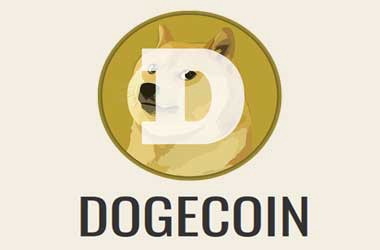
In this article, I'd like to present to you one of my favorite coins to trade and watch. Personally, I do not know of a better example that trades in these predictable waves. Simply following this strategy, has made me some of the largest consistent gains in my trading career to date. Yes, there will be Doge memes to be had in this article as well.
So, lets kick off with a little backstory on $DOGE.
For starters, the most common misconception I see about $DOGE is that it is a dead project. This is false. $DOGE and its work can be followed at @Dogecoin_devs on Twitter and their Github is here.
At one point in my trading career, I was deemed by the community as the “CEO of $DOGE.” While no official role like that exists (I used to get asked this a lot), this coin holds a special place in my heart since it is so profitable to trade its cycles. I am often found on Twitter spreading $DOGE memes and screaming around the time the next cycle should kick off which earned me the unofficial honor. The coin itself is actually really great for use as well. Its fees are cheap and it takes on average about 1 minute to process a transaction on the next Dogecoin block.

The community is amazing too. You'll find numerous Shibas out there who enjoy the novelty of $DOGE and also the fact that its actually a really solid product. Some of my personal favorites are @sabotagebeats, @Noob_charts, @DavidLoveDoge, and @YearOfDoge.

Also, lets not forget $DOGE had its own NASCAR.

So, on to the main topic of this article. The Dogecoin trading cycle.
Of course, nothing is 100% In fact, the chart I will present shows one time where this didn't work, so keep that in mind before you do anything stupid with your money and always utilize your risk management. I am not a financial adviser, the intention of this is to show one of my trading strategies.
Check out the chart below. This is the 3-Day for $DOGE on Bittrex.
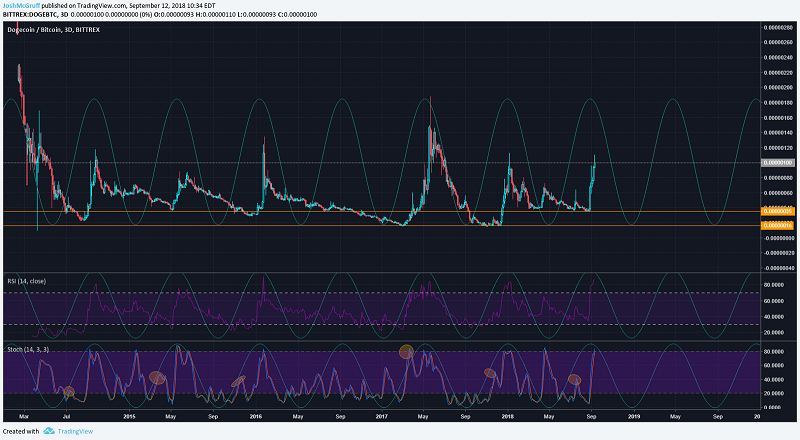
For starters, lets evaluate the two orange lines on the chart. For the history of $DOGE on Bittrex, we've seen rallies start at either the 35 sat resistance line or lower. The current all-time low as of writing is 15 sats.
Next, you can see as shown by the waves as displayed on the candles, RSI, and stoch how they have played out every time on the 3-Day chart except once in September of 2016. As I mentioned, this is not 100%

We can also see the RSI does a pretty good job of following these waves.
What I really think the secret ingredient here is, is the Stoch. My good friend Crypto Core 🏆(you can also find him here on twitter) helped me discover this.
When looking at the Stoch, we can see each rally has a small “pre-pump” on the Stoch inside of the wave. This works as a “heads up” to the next incoming pump as accumulation is happening.
On the one time the Stoch broke above the wave in the pre-pump, we saw the large $DOGE rally to 187 sats.
One should note that there is a long term resistance line at approximate 114 sats that has been respected by 3 rallies (potentially 4 if the current one stops here).
Overall, just accumulating around 35 and lower has been pretty profitable. At those levels, I start to build my bag and average down on price. Once my bag is build, I just sit and wait. It's really that easy. You're not going to make 100x overnight, but you can make some serious gains taking your time and letting this trade come to you.
Each of these cycles have been very profitable from the lowest being 144% in June of 2015 to over 1100% in May of 2017.
$DOGE may appear at first glance to be a dumb meme-coin, but if you take a moment to appreciate it for what it is, it is a wonderful crypto on a technological stance, with a dedicated community, and it is a trend traders dream.
If you'd like to discuss with me, feel free to find me at Ivory Mountain, the Discord trading community I helped found with some great people.
https://hackernoon.com/dogecoin-very-wow-much-cycle-7b1d396ccec7
By: Josh McGruff